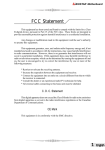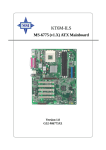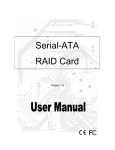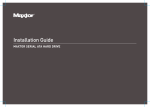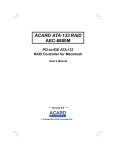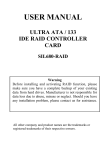Download Gigabyte GA-7VM400MF-P motherboard
Transcript
SATA Host Controller User Manual Revision 1.01 May 19, 2003 Table of Contents Table of Contents...............................................................................................................................................i Introduction ....................................................................................................................................................... 1 RAID Basics................................................................................................................................................... 1 RAID 0 (Striping) ........................................................................................................................................................................ 1 RAID 1 (Mirroring) ..................................................................................................................................................................... 1 JBOD (Spanning)......................................................................................................................................................................... 2 Key Features .................................................................................................................................................. 2 Installing The Hard Drives ............................................................................................................................... 3 BIOS Configuration Utility ............................................................................................................................... 4 Enter BIOS Configuration Utility ............................................................................................................... 4 Create Disk Array ......................................................................................................................................... 5 Delete Disk Array.......................................................................................................................................... 8 Create and Delete Spare Hard Drive .......................................................................................................... 9 Select Boot Array ........................................................................................................................................ 10 View Serial Number of Hard Drive........................................................................................................... 11 View Array Status ....................................................................................................................................... 11 Duplicate Critical RAID 1 Array............................................................................................................... 12 Rebuild Broken RAID 1 Array.................................................................................................................. 13 Driver and RAID Software Installation.......................................................................................................... 15 Microsoft Windows Driver Installation .................................................................................................... 15 Verify Installation ....................................................................................................................................... 17 RAID Software................................................................................................................................................. 18 Installation ................................................................................................................................................... 18 Getting Start ................................................................................................................................................ 19 View Controller and Device Status............................................................................................................ 22 Create Disk Array ....................................................................................................................................... 23 Delete Disk Array........................................................................................................................................ 26 Add and Remove Spare Disk Drive........................................................................................................... 28 Add Spare Disk Drive ................................................................................................................................................................ 28 Remove Spare Disk Drive.......................................................................................................................................................... 30 Check All Disks ........................................................................................................................................... 31 View Event Log ........................................................................................................................................... 32 Verify Mirror Disk...................................................................................................................................... 34 Synchronize Mirror Disk............................................................................................................................ 36 Disk Error Detection................................................................................................................................... 38 Duplicate Critical RAID 1 Array............................................................................................................... 39 Rebuild Broken RAID 1 Array.................................................................................................................. 40 Icon View...................................................................................................................................................... 43 Revision 1.01, May 19, 2003 i Table of Contents INTRODUCTION This section gives a brief introduction on the RAID-related background knowledge and a brief introduction on VIA SATA RAID Host Controller. For users wishing to install their VIA SATA RAID driver and RAID software, proceed to Driver and RAID Software Installation section. RAID Basics RAID (Redundant Array of Independent Disks) is a method of combining two or more hard disk drives into one logical unit. The advantage of an Array is to provide better performance or data fault tolerance. Fault tolerance is achieved through data redundant operation, where if one drives fails, a mirrored copy of the data can be found on another drive. This can prevent data loss if the operating system fails or hangs. The individual disk drives in an array are called “members”. The configuration information of each member is recorded in the “reserved sector” that identifies the drive as a member. All disk members in a formed disk array are recognized as a single physical drive to the operating system. Hard disk drives can be combined together through a few different methods. The different methods are referred to as different RAID levels. Different RAID levels represent different performance levels, security levels and implementation costs. The RAID levels which the VIA VT6420 SATA RAID Host Controller supports are RAID 0, 1, and JBOD. The table below briefly introduced these RAID levels. RAID Level RAID 0 (Striping) No. of Drives 2 to 4 RAID 1 (Mirroring) JBOD (Spanning) 2 2 to 4 Capacity Benefits Number drives * Smallest size Highest performance without data protection Smallest size Data protection Sum of All drives No data protection and performance improving, but disk capacity fully used. RAID 0 (Striping) RAID 0 reads and writes sectors of data interleaved between multiple drives. If any disk member fails, it affects the entire array. The disk array data capacity is equal to the number of drive members times the capacity of the smallest member. The striping block size can be set from 4KB to 64KB. RAID 0 does not support fault tolerance. RAID 1 (Mirroring) RAID 1 writes duplicate data onto a pair of drives and reads both sets of data in parallel. If one of the mirrored drives suffers a mechanical failure or does not respond, the remaining drive will continue to function. Due to redundancy, the drive capacity of the array is the capacity of the smallest drive. Under a RAID 1 setup, an extra drive called the “spare drive” can be attached. Such a drive will be activated to replace a failed drive that is part of a mirrored array. Due to the fault tolerance, if any RAID 1 drive fails, data access will not be affected as long as there are other working drives in the array. Revision 1.01, May 19, 2003 1 Introduction JBOD (Spanning) A spanning disk array is equal to the sum of the all drives when the drives used are having different capacities. Spanning stores data onto a drive until it is full, then proceeds to store files onto the next drive in the array. When any disk member fails, the failure affects the entire array. JBOD is not really a RAID and does not support fault tolerance. Key Features The VIA SATA RAID solution uses the VT6420 chip as a RAID controller, which is a 2-channel SATA and 1-channel ATA133 solution. The RAID software is a Windows-based software utility with graphical user interface that provides an easy-operating tool to configure and manage disk drives or disk arrays connected to the VT6420 controller. Listed below are the main features and benefits of VIA SATA RAID: 1. 2. 3. 4. 5. 6. 7. 8. 9. 10. 11. 12. 13. 14. 15. 16. 17. 18. 19. Support two SATA + two PATA or four SATA hard disk drives. Only SATA supports RAID. Supports ATA 133 high performance hard disk drive. Supports hard disk drive larger than 137 GB (48-bits LBA). Dual independent ATA channels and maximum connection of four hard disk drives allowed. Supports Ultra DMA mode 6/5/4/3/2/1/0, DMA mode 2/1/0, and PIO mode 4/3/2/1/0. Supports PCI Plug and Play. PCI interrupt sharing and coexists with mainboard IDE controller. Supports IDE bus master operation. Supports RAID 0, 1, and JBOD. 4 KB to 64 KB striping block size support. Bootable disk or disk array support. Windows-based RAID configure and management software tool. (Compatible with BIOS) Real-time monitoring of device status and error alarm with popup message box and beeping. Supports hot-swap failed disk drive in RAID 1 array. Mirroring automatic background rebuilds support. ATA SMART function support. Microsoft Windows 98, Me, NT4.0, 2000, XP operating systems support. Event log for easy troubleshooting. On-line help for easy operation for RAID software. Revision 1.01, May 19, 2003 2 Introduction INSTALLING THE HARD DRIVES The VT6420 SATA controller provides the following two configurations: 1. Two SATA + Two PATA Configuration: VT6420 supports two “Master” SATA hard disk drives and one “Master”, one “Slave” PATA hard disk drives. Only SATA hard disk drive supports RAID, so it supports RAID 0, RAID 1, and JBOD. PATA Hard disk drives must be Ultra ATA/133, Ultra ATA/100, Ultra ATA/66, Ultra ATA/33, and/or ATA-3 compatible to operate with the VT6420 SATA RAID controller. 2. Four SATA Configuration: Supports RAID 0, RAID 1, and JBOD. For maximized performance, installing all identical SATA drives of the same model and capacity is recommended. Striping (RAID 0) and JBOD both use two up to four new drives, while mirroring (RAID 1) uses two new drives. Please connect SATA hard disk drivers according to the following table. Number of Drives 1 2 3 4 Revision 1.01, May 19, 2003 SATA Channel 0 Master Master Master & Slave Master & Slave 3 SATA Channel 1 -----Master Master Master & Slave Installing The Hard Drives BIOS CONFIGURATION UTILITY Enter BIOS Configuration Utility When the system powers on, the following information will appear on screen. Press the ‘Tab’ key to enter BIOS configuration utility. The main interface of BIOS configuration utility is as below: Revision 1.01, May 19, 2003 4 BIOS Configuration Utility Create Disk Array 1. Use the arrow keys to navigate the main menu. Use the up and down arrow keys to select the Create Array command and press <Enter> to call out the list of creation steps. Revision 1.01, May 19, 2003 5 BIOS Configuration Utility 2. Select Array Mode and press <Enter>, a list of array modes will appear. Highlight the target array mode that you want to create, and press <Enter> to confirm the selection. If RAID 1 or RAID 0/1 is selected, an option list will popup and enable the users to select Create only or Create and duplicate. Create only will allow BIOS to only create an array. The data on the mirroring drive may be different from the source drive. Create and duplicate lets BIOS copy the data from the source to the mirroring drive. 3. After array mode is selected, there are two methods to create a disk array. One method is “Auto Setup” and the other one is “Select Disk Drives”. Auto Setup allows BIOS to select the disk drives and create arrays automatically, but it does not duplicate the mirroring drives even if the user selected Create and duplicate for RAID 1. It is recommended all disk drives are new ones when wanting to create an array. Select Disk Drives lets the user select the array drives by their requirements. When using Select Disk Drives, the channel column will be activated. Highlight the target drives that you want to use and press <Enter> to select them. After all drives have been selected, press <Esc> to go back to the creation steps menu. Revision 1.01, May 19, 2003 6 BIOS Configuration Utility 4. If user selects a RAID 0 array in step 2, the block size of the array can also be selected. Use the arrow key to highlight Block Size and press <Enter>, then select a block size from the popup menu. The block size can be 4KB to 64KB. 5. Use the arrow key to highlight Start Create Process and press <Enter>. A warning message will appear, Press Y to finish the creation, or press N to cancel the creation. 6. Important note: All existing content in the hard drive will be destroyed after array creation. Revision 1.01, May 19, 2003 7 BIOS Configuration Utility Delete Disk Array A RAID can be deleted after it has been created. To delete a RAID, use the following steps: 1. Select Delete Array in the main menu and press <Enter>. The channel column will be activated. 2. Select the member of an array that is to be deleted and press <Enter>. A warning message will show up, press Y to delete or press N to cancel. Deleting a disk array will destroy all the data on the disk array except RAID 1 arrays. When a RAID is deleted, the data on these two hard disk drives will be reserved and become two normal disk drives. Revision 1.01, May 19, 2003 8 BIOS Configuration Utility Create and Delete Spare Hard Drive If a RAID 1 array is created and there are drives that do not belong to other arrays, the one that has a capacity which is equal to or greater than the array capacity can be selected as a spare drive for the RAID 1 array. Select Create/Delete Spare and press <Enter>, the channel column will then be activated. Select the drive that you want to use as a spare drive and press <Enter>, the selected drive will be marked as Spare. The spare drive cannot be accessed in an OS. To delete a spare drive, highlight Create/Delete Spare and press <Enter>. The spare drive will be highlighted, press <Enter> to delete the spare drive. Revision 1.01, May 19, 2003 9 BIOS Configuration Utility Select Boot Array User can select a disk array as boot device if user wants to boot operating system from an array. Boot disk array cannot be selected if the operating system does not boot from the disk array. Highlight the Select Boot Array item; press <Enter> and the channel column will be activated. Then highlight the target disk array and press <Enter>. If user selects a disk array that has a boot mark and press <Enter>, its boot setting will be canceled. Revision 1.01, May 19, 2003 10 BIOS Configuration Utility View Serial Number of Hard Drive Highlight Serial Number View and press <Enter>. Use arrow key to select a drive, the selected drive’s serial number can be viewed in the last column. The serial number is assigned by the disk drive manufacturer. View Array Status Press the F1 key to show the array status on the lower screen. If there are no disk arrays then nothing will be displayed on the screen. Revision 1.01, May 19, 2003 11 BIOS Configuration Utility Duplicate Critical RAID 1 Array When booting up the system, BIOS will detect if the RAID 1 array has any inconsistencies between user data and backup data. If BIOS detects any inconsistencies, the status of the disk array will be marked as critical, and BIOS will prompt the user to duplicate the RAID 1 in order to ensure the backup data consistency with the user data. If user selects Continue to boot, it will enable duplicating the array after booting into OS. Revision 1.01, May 19, 2003 12 BIOS Configuration Utility Rebuild Broken RAID 1 Array When booting up the system, BIOS will detect if any member disk drives of RAID has failed or is absent. If BIOS detects any disk drive failures or missing disk drives, the status of the array will be marked as broken. If BIOS detects a broken RAID 1 array but there is a spare hard drive available for rebuilding the broken array, the spare hard drive will automatically become the mirroring drive. BIOS will show a main interface just like a duplicated RAID 1. Selecting Continue to boot enables the user to duplicate the array after booting into operating system. If BIOS detects a broken RAID 1 array but there is no spare hard drive available for rebuilding the array, BIOS will provide several operations to solve such problem. Revision 1.01, May 19, 2003 13 BIOS Configuration Utility 1. Power off and Check the Failed Drive: This item turns off the computer and replaces the failed hard drive with a good one. If your computer does not support APM, you must turn off your computer manually. After replacing the hard drive, boot into BIOS and select Choose replacement drive and rebuild to rebuild the broken array. 2. Destroy the Mirroring Relationship: This item cancels the data mirroring relationship of the broken array. For broken RAID 1 arrays, the data on the surviving disk will remain after the destroy operation. However, Destroy the Mirroring Relationship is not recommend because the data on the remaining disk will be lost when the hard drive is used to create another RAID 1 array. 3. Choose Replacement Drive and Rebuild: This item enables users to select an already-connected hard drive to rebuild the broken array. After choosing a hard drive, the channel column will be activated. Highlight the target hard drive and press <Enter>, a warning message will appear. Press Y to use that hard drive to rebuild, or press N to cancel. Please note selecting option Y will destroy all the data on the selected hard drive. 4. Continue to boot: This item enables BIOS to skip the problem and continue booting into OS. Revision 1.01, May 19, 2003 14 BIOS Configuration Utility DRIVER AND RAID SOFTWARE INSTALLATION Microsoft Windows Driver Installation 1. After Windows has finished booting up, the system will automatically find the newly installed adapter and prompt the Found New Hardware Wizard window. Click Cancel to skip it. 2. Insert the RAID driver and software installation CD or diskettes. Browse the CD or diskettes and double click on setup.exe to begin the driver and software installation. Revision 1.01, May 19, 2003 15 Driver and RAID Software Installation 3. Confirm the follow-up dialogue windows to finish the installation. 4. When installation is completed, click Finish to restart the system. Revision 1.01, May 19, 2003 16 Driver and RAID Software Installation Verify Installation After the driver installation is completed and the system has restarted: 1. Right-click on My Computer and select Properties from the popup menu. 2. From the popup window, click on Hardware and then click on Device Manager. 3. Expand the SCSI and RAID controllers tree as shown below. If the VIA IDE RAID Host Controller does not exist or there is a “?” or “!” marking on the device icon, it means the driver has not been installed correctly and needs to be reinstalled. Revision 1.01, May 19, 2003 17 Driver and RAID Software Installation RAID SOFTWARE Installation The RAID software is installed simultaneously with driver installation. Revision 1.01, May 19, 2003 18 RAID Software Getting Start After installing the GUI software, it will be automatically started every time Windows is initiated. An icon the system tray of the tool bar to indicate that GUI software is currently running. will appear in Double click on the system tray icon to launch the main interface of the utility. Revision 1.01, May 19, 2003 19 RAID Software The main interface is divided into two windows and the toolbar above contain the main functions. Click on these toolbar buttons to execute their specific functions. The left windowpane displays the controller and disk drives and the right windowpane displays the details of the controller or disk drives. View by Controller Create Mirror Array (RAID 1) Create Span Array (JBOD) Create Stripe Array (RAID 0) Add/Remove Spare disk Remove Array View Event log Check All Disks View by Devices Help Topics Revision 1.01, May 19, 2003 20 RAID Software View Online Help Click on to launch the Help Topics. It is recommended that you read through the help articles before using RAID utility. Revision 1.01, May 19, 2003 21 RAID Software View Controller and Device Status Click on or button to determine the viewing type of left windowpane. There are two viewing types: By controllers and by device. Click on the object in the left windowpane to display the status of the object in the right windowpane. Revision 1.01, May 19, 2003 22 RAID Software Create Disk Array 1. Depending on users’ preferences, there are three buttons used to create a disk array: RAID 1, RAID 0. Click on the RAID button you want to create, the Select Array Creating Method will be displayed. Span, and Auto: The utility will arrange the available hard disk drives to be the disk arrays. The hard disk drives can still be modified later. This method is strongly recommended. Custom: The utility will provide an interface to manually arrange the array. Revision 1.01, May 19, 2003 23 RAID Software 2. Click on Auto to launch the creating array window. If Custom is selected, the available disks window lists the available disk drives that can be used to create the array. Select a disk drive and click on the right arrow button to add the specified disk drive to the array. Disk drives can be removed from the array by selecting an array disk and clicking on the left arrow button to remove the drive from the array. Click on “Create” to create or “Cancel” to exit. Click on “Help” to launch the Help Topics window. Revision 1.01, May 19, 2003 24 RAID Software 3. A warning message will pop up after clicking on Create button. Click Yes to finish the creation of disk array, or No to cancel. 4. A message box will popup to prompt the user that disk array has been created successfully and ask the user whether to restart the computer. Click Yes to restart the computer or click No to skip restarting. The new disk array setting will take effect only after restarting. Revision 1.01, May 19, 2003 25 RAID Software Delete Disk Array 1. Select the disk array that you want to delete from the left windowpane, click on Remove Array will pop up. 2. Click Yes to delete the specified disk array or click No to cancel. Revision 1.01, May 19, 2003 26 , a warning message RAID Software 3. A message box will popup to prompt the user that disk array has been removed successfully and ask the user whether to restart the computer. Click Yes to restart the computer or click No to skip restarting. The new setting will take effect only after restarting. Warning: Deleting a disk array will destroy all the data on the disk array except RAID 1 arrays. When a RAID 1 array is deleted, the data on these two hard disk drives will still remain and become two normal disk drives. Revision 1.01, May 19, 2003 27 RAID Software Add and Remove Spare Disk Drive Add Spare Disk Drive A spare disk drive can be added when a RAID 1 array is created. The capacity of the spare disk drive must be greater than or equal to the capacity of the RAID 1 array. If there is no spare disk drive in a RAID 1 array, user can add a spare disk drive after RAID 1 array is created by clicking on . 1. Select the RAID 1 array in the left windowpane and click on window. , the available disk drives will then be listed in a popup 2. Select a disk drive and click on OK to add a spare disk drive to RAID 1. 3. A warning message will popup, click Yes to finish adding the spare disk or No to cancel it. Revision 1.01, May 19, 2003 28 RAID Software 4. A message box will popup to prompt the user that a spare disk drive has been successfully added to the specific RAID 1 array, and ask whether the user would like to restart the computer. Click Yes to restart the computer or click No to skip restarting. The new setting will take effect only after restarting. Note: The spare disk drive in the RAID 1 array cannot be accessed by the operating system. Revision 1.01, May 19, 2003 29 RAID Software Remove Spare Disk Drive Spare disk drives can be removed from a specified RAID 1 and changed into normal hard disk drives. 1. Select the RAID 1 array that you want to remove from the spare disk drives in the left windowpane, and click on warning message will popup. ,a 2. Click Yes to finish removing spare disk, or No to cancel. 3. A message box will popup to prompt the user that the spare disk drive has been successfully removed from specific RAID 1 array, and ask the user whether to restart the computer. Click Yes to restart the computer or click No to skip restarting. The new setting will take effect only after restarting Revision 1.01, May 19, 2003 30 RAID Software Check All Disks You can check whether the disk drives are working normally at any time by clicking on a dialog window will pop up to show the status of each disk. See picture below. . After the disk check is completed, The hard disk drive must be compatible with the ATA/ATAPI-5 specification and support SMART commands, or the disk checking will fail. Revision 1.01, May 19, 2003 31 RAID Software View Event Log The RAID software records important events into a log file, such as disk array creation, disk array removal, disk failure, synchronization…etc. 1. Click on to display the event log. There are three types of log items: Information Revision 1.01, May 19, 2003 32 , Warning , and Error . RAID Software 2. To view the details of a log item, you can double click on the log item, select the log item and press <Enter>, or select the log item and click on Operation->View Detail in the menu bar. The following dialog will appear. Click on or to browse the next or previous log item. 3. To clear all log items, click on Operation->Clear All in the menu bar. Note: Only the operations in the RAID software can be recorded into the log file. The operations in BIOS will not be recorded. Revision 1.01, May 19, 2003 33 RAID Software Verify Mirror Disk The data on the mirror disk must be the same with its corresponding source disk to provide fault tolerance for RAID 1. 1. Select a RAID 1 array. Right-click the selected RAID, then a shortcut menu will be shown. Click on Verify Mirror to verify whether the source and mirror are identical. Revision 1.01, May 19, 2003 34 RAID Software 2. After executing the “verify mirror” command, a dialog box will show the verifying process. This action can paused or canceled at any time. It may take a long time to verify the source and mirror disk if the capacity of the RAID is large. 3. When mirror disk is not identical with the corresponding source disk, the mirror disk will be marked with a “need-sync” flag. The icon used to indicate this status is Revision 1.01, May 19, 2003 . A “need-sync” mirror disk should be synchronized as soon as possible. 35 RAID Software Synchronize Mirror Disk RAID 1 arrays must be synchronized when the data on the mirror disk is not identical with its corresponding source disk. Sometimes the data on the mirror disk may be newer than the data on the source disk. For example, the source disk is absent and the mirror disk runs in the tolerance mode. So the exact meaning of “Synchronize Mirror” is to make a pair of source and mirror disks contain identical data. The RAID software always marks the mirror disk with a “need-sync” icon the mirror disk may have the correct data. despite the fact that 1. Select a RAID 1 array, right-click the selected RAID and a shortcut menu will be shown. Click on Synchronize Mirror to synchronize the source and mirror disks. Revision 1.01, May 19, 2003 36 RAID Software 2. After synchronization has started, a dialog box will show the process. This action can be paused or canceled at any time. 3. An informing message will appear when the synchronization is finished. Revision 1.01, May 19, 2003 37 RAID Software Disk Error Detection The RAID software will pop up an error message if a disk drive fails or missing. Revision 1.01, May 19, 2003 38 RAID Software Duplicate Critical RAID 1 Array When booting up the system, the RAID utility will detect if there are any inconsistencies between the source and mirror disk drives of the RAID 1 array. If the software detects that a RAID 1 array has any inconsistencies, the status of the disk array will be marked as critical and the software will prompt the user to duplicate RAID 1, as to make the mirror disk consistent with the corresponding source disk. You can click Yes to synchronize now or click No to synchronize later. After synchronization has started, a dialog box will show the process and this action can be paused or canceled at any time. If the synchronization process is cancelled, the RAID will be on the “need-sync” condition and synchronization should be proceeding again to guarantee the data consistency between sources and mirror disk drives. A message will pop up when the synchronization process is finished. Revision 1.01, May 19, 2003 39 RAID Software Rebuild Broken RAID 1 Array After booting up the system, the RAID utility will detect if any member disk drives of the RAID 1 array has failed or is absent. If the RAID utility detects any disk drive failures or missing disk drives, the status of the array will be marked as broken. If the RAID software detects a RAID 1 array being broken, and there is a spare hard drive that could be used to rebuild the broken array, the spare hard drive will automatically become the mirroring drive. Software will remind users to synchronize this RAID like the duplicating RAID 1. If the RAID software detects a RAID 1 array being broken but there is no spare hard drive, the RAID software will indicate a series of steps to repair such problem. 1. A dialog box will be shown to indicate that the RAID is broken. Click Yes to repair the array. 2. Another dialog box will pop up. If the source or mirror disk drive is unplugged only, click Cancel to stop the rebuilding process and shut down the system. Plug in the absent disk drive and then reboot system. If the original disk drive is broken, plug in a new disk drive and then reboot the system. Click Next to proceed to the next step. Revision 1.01, May 19, 2003 40 RAID Software 3. Select a disk drive from Available Disks and click on Revision 1.01, May 19, 2003 to replace the broken drive and then click Next. 41 RAID Software 4. A warning message will appear. If you want to rebuild the RAID using the disk driver that you selected in the previous step, click Next. Warning: All the data on the selected disk drive will be lost. 5. Reboot the system 6. This RAID is marked as a critical RAID. The RAID software will duplicate this critical RAID 1 process. Revision 1.01, May 19, 2003 42 RAID Software Icon View All icon types and their corresponding meanings are listed below. The real status of an array or a disk drive is described on “Array status” or “Device status” in the right windowpane. Normal Disk Array Disk Array with Warning status Broken Disk Array Disk Drive with Normal status Absent Disk Drive in a Array Disk Drive with Error Disk Drive with Warning status The pair of Source and Mirror Disks should be synchronized Disk Drive which needs system rebooting to enable its function. Revision 1.01, May 19, 2003 43 RAID Software















































